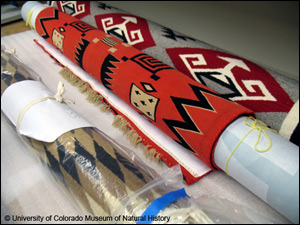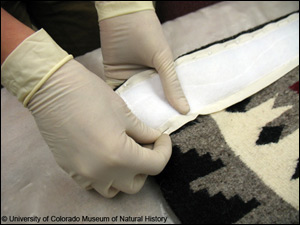



The American Institute for Conservation and Historic Works defines conservation as
The profession devoted to the preservation of cultural property for the future. Conservation activities include examination, documentation, treatment, and preventive care, supported by research and education.
 Preventive care is one of the most important aspects of caring for textile collections. It involves:
Preventive care is one of the most important aspects of caring for textile collections. It involves:
The following are the primary deteriorating factors for textiles:
 The weavings in this exhibit were first reviewed for condition. Does the textile have holes or other instabilities? Is there soiling or staining? Is there extensive fading of the dyes? What is the exhibition history of the object?
The weavings in this exhibit were first reviewed for condition. Does the textile have holes or other instabilities? Is there soiling or staining? Is there extensive fading of the dyes? What is the exhibition history of the object?
Once the checklist was determined, it was decided if the textile could be hung vertically or had to remain flat or on a slant board. More fragile textiles are displayed flat so that less stress is placed on the weaving, causing potential damages.
Weavings that are displayed vertically are hung using Velcro. The loop (soft) side of the Velcro is first machine-stitched to a length of unbleached cotton muslin. The muslin is then hand-stitched to the textile. The stitches are staggered so that the stress of the hanging is distributed. Care is taken to stitch between the yarns, so that the individual yarns of the weaving are not spit. The textile is then attached to the hook side of the Velcro which is affixed to a wooden slat.
Damaged textiles were repaired on the back with non-permanent patches.
The best storage for any textile is to remain flat, in acid-free materials. This is not practical for most larger pieces, such as many of the weavings in this exhibit. Weavings can be rolled onto acid-free tubes and covered with washed, unbleached muslin covers. Navajo textiles can also be folded (in one direction) with padded folds using acid-free tissue.
A conservator can help with any questions regarding the care, storage, or display of your textiles, particularly if there are questions about cleaning or stabilization of damaged weavings.
The American Institute for Conservation of Historic and Artistic Works (AIC)
The American Institute for Conservation and Historic and Artistic Works is a national organization for conservators. It also offers educational resources and help finding a conservator.
Smithsonian Museum Conservation institute (MCI)
Minnesota Historical Society
Includes answers to frequently asked questions about caring for textiles.
Canadian Conservation Institute
National Park Service Conserve O Grams
Conserve O Grams are short leaflets about caring for museum objects.